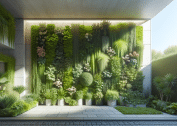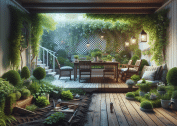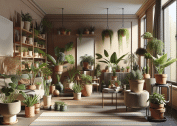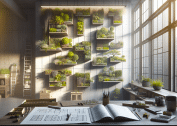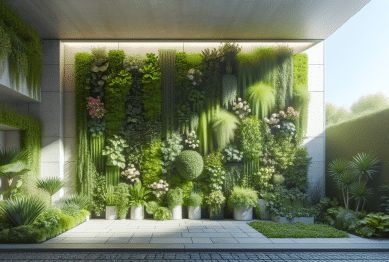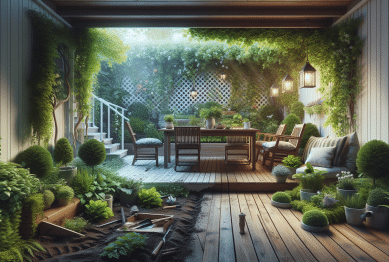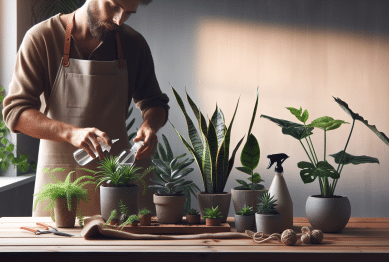Curious how to create a more inviting backyard without major renovations? This guide explores eco-friendly landscaping, low-maintenance gardening, affordable outdoor design, and smart planting strategies that can help transform your home’s green space into an enjoyable retreat all year round.
Eco-Friendly Landscaping Solutions for Modern Yards
Eco-friendly landscaping has gained momentum among homeowners keen on reducing environmental impact while adding value to their property. By embracing sustainable planting choices and water-wise gardening, it’s possible to refresh your green spaces and support biodiversity. For instance, replacing a portion of your turf with native plants reduces the need for excessive irrigation and maintenance, as these flora adapt naturally to local climate conditions. Native shrubs and wildflowers encourage pollinators like bees and butterflies, which are essential for a healthy garden ecosystem.
Water conservation lies at the heart of eco-friendly landscaping. Simple steps like capturing rainwater in barrels or installing drip irrigation systems keep plants healthy without the inefficiencies of sprinklers. A mulched garden bed locks in soil moisture, suppresses weeds, and helps moderate temperatures around your plant roots. Homeowners are increasingly choosing these sustainable methods, not only to create a vibrant outdoor space but also to make meaningful contributions to water conservation efforts. The shift toward eco-landscaping doesn’t require radical changes—smart incremental upgrades yield visible improvements over time.
Designing with sustainability in mind also involves rethinking lawn size and composition. Lawns, while popular, consume significant resources. Shrinking turf areas in favor of native groundcovers or ornamental grasses provides a textured look and eases upkeep. Consider creating a wild meadow patch that erupts with color, needs little mowing, and becomes a sanctuary for birds. A sustainable landscape invites relaxation, offers year-round visual interest, and supports balanced ecosystems without demanding constant maintenance. Even small steps lead to a big change in how the backyard looks—and how it functions for wildlife and homeowners alike.
Low-Maintenance Gardening for Year-Round Color
Low-maintenance gardening has become an attractive option for busy families and individuals. Selecting perennial plants that thrive in your climate means less work, as these return each year with minimal intervention. Ornamental grasses, daylilies, and hostas provide consistent foliage and blooms throughout the seasons. Strategic planting based on sun exposure and soil conditions increases your garden’s resilience and lowers the need for watering or fertilizing. Smart plant choices can result in dynamic colors and textures all year, reducing effort and maximizing the visual pay-off.
The secret to effortless gardening is thoughtful layout. Grouping plants with similar needs allows for more efficient watering and minimizes the risk of disease or pest outbreaks. Raised beds and mulched borders control weeds naturally while maintaining garden structure. Incorporating evergreens adds lasting greenery in winter, providing interest even when flowers fade. Many homeowners also integrate herbs like rosemary and lavender, which are both hardy and edible, adding a practical element to garden design.
Adapting your garden to a low-maintenance approach doesn’t mean sacrificing creativity or diversity. Perennial borders can be mixed with flowering bulbs for a burst of early spring color. Self-seeding annuals fill gaps with surprises year after year. Rock gardens, featuring succulents or drought-tolerant groundcovers, are low-effort and highly decorative. These strategies balance aesthetics with ease of care, transforming outdoor areas into inviting sanctuaries with minimal labor.
Affordable Outdoor Upgrades to Refresh Your Space
Refreshing a backyard doesn’t always require expensive projects or professional help. Small, intentional upgrades can have a big impact on appearance and function. Installing a simple gravel path or edging adds neatness and guides foot traffic. Painting or sealing existing outdoor furniture gives it a renewed look at a fraction of the cost of new pieces. Lighting, whether solar lanterns or string lights, instantly enhances the ambiance and makes evenings more enjoyable.
Repurposing materials saves money and contributes to sustainability. Old bricks or pavers can form charming patios or raised planters. Salvaged pallets create rustic benches, planters, or vertical gardens for growing herbs and flowers. Even a fresh coat of outdoor paint on fences or sheds provides a crisp, fresh backdrop. Upcycling ideas let you personalize your backyard while staying within budget. These small investments improve usability and comfort in a way that feels rewarding and unique.
Functional upgrades make outdoor spaces more livable. Installing a rain barrel, planting a privacy hedge, or building a simple compost bin all count as affordable enhancements. These additions not only add visual value but provide direct benefits—captured rainwater for irrigation or organic compost for feeding plants. Thoughtful improvements like these help create a backyard that aligns with your lifestyle, budget, and sustainability values.
Creating Wildlife-Friendly Habitats at Home
Turning your backyard into a wildlife-friendly zone is a gratifying way to connect with nature. Providing sources of food, water, and shelter encourages beneficial insects, birds, and small animals. Incorporating a mix of flowering plants throughout the year ensures consistent food sources for pollinators. Birdbaths, feeders, and nesting boxes offer safe havens for avian visitors. Even a small pond or water feature attracts frogs and dragonflies, enriching your outdoor ecosystem.
Native plantings enhance biodiversity. Local birds and pollinators depend on native flowers, shrubs, and trees for nutrition and habitat. Whenever possible, avoid pesticides and herbicides. These chemicals disrupt delicate ecological balances and harm unintended species. Mulched borders, organic gardening practices, and non-invasive weeding all support a thriving, balanced environment. Over time, you may spot new species and witness complex interactions unfold in your backyard.
Design choices can prioritize wildlife support without compromising aesthetics. Layered planting designs mimic forest edges, combining tall trees, mid-level shrubs, and ground-level perennials. Leaving a brush pile or a patch of longer grass creates shelter for overwintering insects and small mammals. These small gestures make your home landscape more inviting to wildlife while still delivering visual appeal and low-maintenance benefits. Watching birds, butterflies, and other visitors transforms your backyard into a living, ever-changing scene.
Smart Planting Strategies for Small Spaces
Small backyards, patios, or balconies require clever planting solutions to maximize beauty without feeling crowded. Container gardening allows you to experiment with colors, textures, and layouts in tight spaces. Vertical planters, trellises, or wall-mounted systems make use of unused vertical space, adding visual interest and growing power. Compact, bushy varieties of vegetables, herbs, or flowers are ideal for planters and urban gardens. Raised beds define zones and minimize soil compaction, letting you grow more in less area.
Succession planting—replenishing beds with new crops as old ones finish—keeps gardens productive throughout the growing season. Interplanting leafy greens or root vegetables under taller crops utilizes every available inch. Herbs like basil or chives fit easily around main plantings, filling unused space with fragrance and harvestable produce. Creative placement turns the smallest areas into abundant, multi-functional gardens for cooking, relaxation, or visual pleasure.
Mulching, companion planting, and careful attention to sunlight create healthy, thriving garden beds even where space is scarce. Mobile containers allow flexibility—move them to catch the sun or shield from wind. Subtle screening, such as tall planters or climbing vines on fences, adds privacy. Overall, these smart planting tactics help transform small yards or balconies into eye-catching retreats that invite you outdoors, regardless of size.
Year-Round Enjoyment: Outdoor Living Made Easy
Your backyard should be welcoming every season, not just in summer. Additions like shade sails or pergolas create cooled retreats in hot weather and shelter when it’s rainy. Fire pits, chimeneas, or simple portable heaters make outdoor evenings possible well into autumn. Soft furnishings such as outdoor cushions, rugs, and weatherproof fabrics turn patios into cozy living spaces you’ll want to use again and again.
Consider plants that add interest in each season. Early bulbs like crocus or tulips ignite spring with color. Summer-blooming perennials dazzle under the sun. In autumn, vivid foliage and ornamental grasses maintain beauty as temperatures drop. Even winter offers surprises with structural plants and evergreens. Layering plant choices ensures something captivates the eye—no matter the month.
Lighting, water features, and comfortable seating bring everything together for all-season outdoor enjoyment. Thoughtful layout—ensuring walkways are clear and surfaces are safe—makes transitions between indoor and outdoor spaces seamless year-round. The result is a backyard that evolves with your needs, sustaining joy and relaxation every time you step outside.
References
1. United States Environmental Protection Agency. (2023). Backyard Conservation Tips. Retrieved from https://www.epa.gov/soakuptherain/soak-rain-backyard-conservation-tips
2. Lady Bird Johnson Wildflower Center. (2022). Native Plants for Landscaping. Retrieved from https://www.wildflower.org/
3. National Wildlife Federation. (2023). Certified Wildlife Habitat. Retrieved from https://www.nwf.org/certifiedwildlifehabitat
4. University of California Agriculture and Natural Resources. (2022). Water-wise Gardening. Retrieved from https://ucanr.edu/sites/WUCOLS/
5. Royal Horticultural Society. (2024). Gardening for Wildlife. Retrieved from https://www.rhs.org.uk/wildlife
6. Oregon State University Extension Service. (2022). Low Maintenance Gardening. Retrieved from https://extension.oregonstate.edu/gardening/techniques/low-maintenance-gardening


